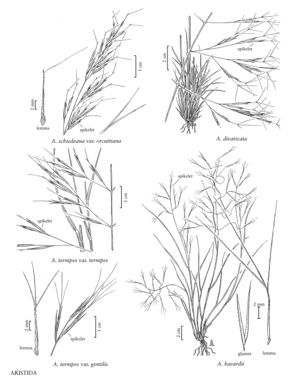Difference between revisions of "Aristida divaricata"
FNA>Volume Importer |
FNA>Volume Importer |
||
| Line 38: | Line 38: | ||
|publication year= | |publication year= | ||
|special status= | |special status= | ||
| − | |source xml=https://jpend@bitbucket.org/aafc-mbb/fna-data-curation.git/src/ | + | |source xml=https://jpend@bitbucket.org/aafc-mbb/fna-data-curation.git/src/f6b125a955440c0872999024f038d74684f65921/coarse_grained_fna_xml/V25/V25_995.xml |
|subfamily=Poaceae subfam. Aristidoideae | |subfamily=Poaceae subfam. Aristidoideae | ||
|tribe=Poaceae tribe Aristideae | |tribe=Poaceae tribe Aristideae | ||
Revision as of 19:26, 24 September 2019
Plants perennial; cespitose. Culms 25-70 cm, erect or prostrate, unbranched or sparingly branched. Leaves tending to be basal; sheaths longer than the internodes, glabrous except at the summit; collars densely pilose; ligules 0.5-1 mm; blades 5-20 cm long, 1-2 mm wide, flat to loosely involute, glabrous. Inflorescences paniculate, 10-30 cm long, 6-25 cm wide, peduncles flattened and easily broken; rachis nodes glabrous or with hairs, hairs to 0.5 mm; primary branches 5-13 cm, stiffly divaricate to reflexed, with axillary pulvini, usually naked on the basal 1/2; secondary branches usually well-developed. Spikelets overlapping, usually appressed, sometimes divergent and the pedicels with axillary pulvini. Glumes 8-12 mm, 1-veined, acuminate or shortly awned, awns to 4 mm; calluses about 0.5 mm; lemmas 8-13 mm long, the terminal 2-3 mm with 4 or more twists when mature, narrowing to 0.1-0.2 mm wide just below the awns, junction with the awns not evident; awns (7)10-20 mm, not disarticulating at maturity; central awns almost straight to curved at the base, ascending to somewhat divergent distally; lateral awns slightly thinner and from much to slightly shorter than the central awns, ascending to divergent; anthers 3, 0.8-1 mm. Caryopses 8-10 mm, light brown. 2n = 22.
Distribution
Kans., Okla., Colo., Calif., N.Mex., Tex., Ariz.
Discussion
Aristida divaricata grows on dry hills and plains, especially in pinyon-juniper-grassland zones, from the southwestern United States through Mexico to Guatemala. It occasionally intergrades with A. havardii, but that species has lemma beaks that are straight or have only 1-2 twists, shorter primary branches, usually no secondary branches, and pedicels that more frequently have axillary pulvini so the spikelets are more frequently divergent than in A. divaricata.
Selected References
None.
